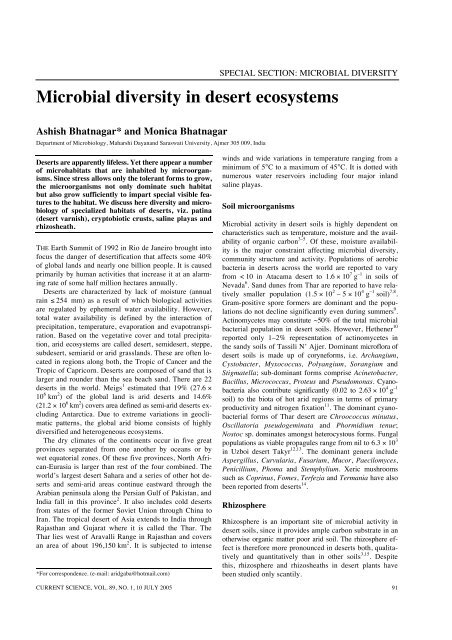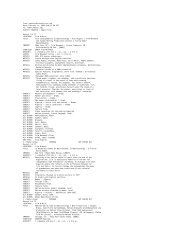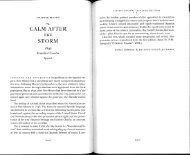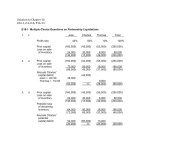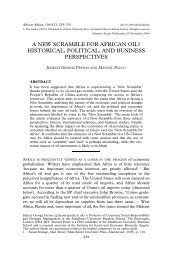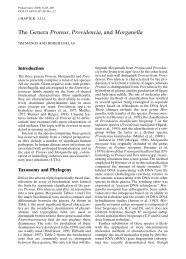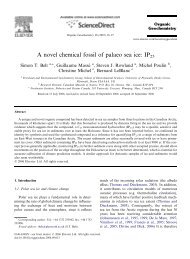Microbial diversity in desert ecosystems
Microbial diversity in desert ecosystems
Microbial diversity in desert ecosystems
You also want an ePaper? Increase the reach of your titles
YUMPU automatically turns print PDFs into web optimized ePapers that Google loves.
SPECIAL SECTION: MICROBIAL DIVERSITY<br />
<strong>Microbial</strong> <strong>diversity</strong> <strong>in</strong> <strong>desert</strong> <strong>ecosystems</strong><br />
Ashish Bhatnagar* and Monica Bhatnagar<br />
Department of Microbiology, Maharshi Dayanand Saraswati University, Ajmer 305 009, India<br />
Deserts are apparently lifeless. Yet there appear a number<br />
of microhabitats that are <strong>in</strong>habited by microorganisms.<br />
S<strong>in</strong>ce stress allows only the tolerant forms to grow,<br />
the microorganisms not only dom<strong>in</strong>ate such habitat<br />
but also grow sufficiently to impart special visible features<br />
to the habitat. We discuss here <strong>diversity</strong> and microbiology<br />
of specialized habitats of <strong>desert</strong>s, viz. pat<strong>in</strong>a<br />
(<strong>desert</strong> varnish), cryptobiotic crusts, sal<strong>in</strong>e playas and<br />
rhizosheath.<br />
THE Earth Summit of 1992 <strong>in</strong> Rio de Janeiro brought <strong>in</strong>to<br />
focus the danger of <strong>desert</strong>ification that affects some 40%<br />
of global lands and nearly one billion people. It is caused<br />
primarily by human activities that <strong>in</strong>crease it at an alarm<strong>in</strong>g<br />
rate of some half million hectares annually.<br />
Deserts are characterized by lack of moisture (annual<br />
ra<strong>in</strong> ≤ 254 mm) as a result of which biological activities<br />
are regulated by ephemeral water availability. However,<br />
total water availability is def<strong>in</strong>ed by the <strong>in</strong>teraction of<br />
precipitation, temperature, evaporation and evapotranspiration.<br />
Based on the vegetative cover and total precipitation,<br />
arid <strong>ecosystems</strong> are called <strong>desert</strong>, semi<strong>desert</strong>, steppe,<br />
sub<strong>desert</strong>, semiarid or arid grasslands. These are often located<br />
<strong>in</strong> regions along both, the Tropic of Cancer and the<br />
Tropic of Capricorn. Deserts are composed of sand that is<br />
larger and rounder than the sea beach sand. There are 22<br />
<strong>desert</strong>s <strong>in</strong> the world. Meigs 1 estimated that 19% (27.6 ×<br />
10 6 km 2 ) of the global land is arid <strong>desert</strong>s and 14.6%<br />
(21.2 × 10 6 km 2 ) covers area def<strong>in</strong>ed as semi-arid <strong>desert</strong>s exclud<strong>in</strong>g<br />
Antarctica. Due to extreme variations <strong>in</strong> geoclimatic<br />
patterns, the global arid biome consists of highly<br />
diversified and heterogeneous <strong>ecosystems</strong>.<br />
The dry climates of the cont<strong>in</strong>ents occur <strong>in</strong> five great<br />
prov<strong>in</strong>ces separated from one another by oceans or by<br />
wet equatorial zones. Of these five prov<strong>in</strong>ces, North African-Eurasia<br />
is larger than rest of the four comb<strong>in</strong>ed. The<br />
world’s largest <strong>desert</strong> Sahara and a series of other hot <strong>desert</strong>s<br />
and semi-arid areas cont<strong>in</strong>ue eastward through the<br />
Arabian pen<strong>in</strong>sula along the Persian Gulf of Pakistan, and<br />
India fall <strong>in</strong> this prov<strong>in</strong>ce 2 . It also <strong>in</strong>cludes cold <strong>desert</strong>s<br />
from states of the former Soviet Union through Ch<strong>in</strong>a to<br />
Iran. The tropical <strong>desert</strong> of Asia extends to India through<br />
Rajasthan and Gujarat where it is called the Thar. The<br />
Thar lies west of Aravalli Range <strong>in</strong> Rajasthan and covers<br />
an area of about 196,150 km 2 . It is subjected to <strong>in</strong>tense<br />
*For correspondence. (e-mail: aridgaba@hotmail.com)<br />
w<strong>in</strong>ds and wide variations <strong>in</strong> temperature rang<strong>in</strong>g from a<br />
m<strong>in</strong>imum of 5°C to a maximum of 45°C. It is dotted with<br />
numerous water reservoirs <strong>in</strong>clud<strong>in</strong>g four major <strong>in</strong>land<br />
sal<strong>in</strong>e playas.<br />
Soil microorganisms<br />
<strong>Microbial</strong> activity <strong>in</strong> <strong>desert</strong> soils is highly dependent on<br />
characteristics such as temperature, moisture and the availability<br />
of organic carbon 3–5 . Of these, moisture availability<br />
is the major constra<strong>in</strong>t affect<strong>in</strong>g microbial <strong>diversity</strong>,<br />
community structure and activity. Populations of aerobic<br />
bacteria <strong>in</strong> <strong>desert</strong>s across the world are reported to vary<br />
from < 10 <strong>in</strong> Atacama <strong>desert</strong> to 1.6 × 10 7 g –1 <strong>in</strong> soils of<br />
Nevada 6 . Sand dunes from Thar are reported to have relatively<br />
smaller population (1.5 × 10 2 – 5 × 10 4 g –1 soil) 7,8 .<br />
Gram-positive spore formers are dom<strong>in</strong>ant and the populations<br />
do not decl<strong>in</strong>e significantly even dur<strong>in</strong>g summers 9 .<br />
Act<strong>in</strong>omycetes may constitute ~50% of the total microbial<br />
bacterial population <strong>in</strong> <strong>desert</strong> soils. However, Hethener 10<br />
reported only 1–2% representation of act<strong>in</strong>omycetes <strong>in</strong><br />
the sandy soils of Tassili N’ Ajjer. Dom<strong>in</strong>ant microflora of<br />
<strong>desert</strong> soils is made up of coryneforms, i.e. Archangium,<br />
Cystobacter, Myxococcus, Polyangium, Sorangium and<br />
Stigmatella; sub-dom<strong>in</strong>ant forms comprise Ac<strong>in</strong>etobacter,<br />
Bacillus, Micrococcus, Proteus and Pseudomonas. Cyanobacteria<br />
also contribute significantly (0.02 to 2.63 × 10 4 g –1<br />
soil) to the biota of hot arid regions <strong>in</strong> terms of primary<br />
productivity and nitrogen fixation 11 . The dom<strong>in</strong>ant cyanobacterial<br />
forms of Thar <strong>desert</strong> are Chroococcus m<strong>in</strong>utus,<br />
Oscillatoria pseudogem<strong>in</strong>ata and Phormidium tenue;<br />
Nostoc sp. dom<strong>in</strong>ates amongst heterocystous forms. Fungal<br />
populations as viable propagules range from nil to 6.3 × 10 3<br />
<strong>in</strong> Uzboi <strong>desert</strong> Takyr 12,13 . The dom<strong>in</strong>ant genera <strong>in</strong>clude<br />
Aspergillus, Curvularia, Fusarium, Mucor, Paecilomyces,<br />
Penicillium, Phoma and Stemphylium. Xeric mushrooms<br />
such as Copr<strong>in</strong>us, Fomes, Terfezia and Termania have also<br />
been reported from <strong>desert</strong>s 14 .<br />
Rhizosphere<br />
Rhizosphere is an important site of microbial activity <strong>in</strong><br />
<strong>desert</strong> soils, s<strong>in</strong>ce it provides ample carbon substrate <strong>in</strong> an<br />
otherwise organic matter poor arid soil. The rhizosphere effect<br />
is therefore more pronounced <strong>in</strong> <strong>desert</strong>s both, qualitatively<br />
and quantitatively than <strong>in</strong> other soils 3,15 . Despite<br />
this, rhizosphere and rhizosheaths <strong>in</strong> <strong>desert</strong> plants have<br />
been studied only scantily.<br />
CURRENT SCIENCE, VOL. 89, NO. 1, 10 JULY 2005 91
SPECIAL SECTION: MICROBIAL DIVERSITY<br />
Generally R : S (rhizosphere : soil) ratio is high <strong>in</strong> arid<br />
soils for nearly all metabolic types of bacteria (viz. heterotrophs,<br />
diazotrophs, cellulolytes and nitrifiers) and<br />
fungi <strong>in</strong> most plants studied 8,16–18 . Yet the rhizosphere effect<br />
on different groups of microorganisms varies from one<br />
plant species to other 8 . Of six <strong>desert</strong> range plant species<br />
of Iraq, namely Acillea sp., Aristida plumosa, Artemesia<br />
herba-alba, Haloxylon articulatum and Hellotropium<br />
ramosissimum, rhizosphere of Aristida plumosa had maximum<br />
Azotobacter population while Artemesia sp. the<br />
least 19 . Khathuria 8 observed that Datura metal did not<br />
have any significant effect on total heterotrophic count,<br />
but showed a high R : S ratio for diazotrophs, nitrifiers,<br />
act<strong>in</strong>omycetes and fungi. The high density of microorganisms<br />
<strong>in</strong> a shrub rhizosphere is suggested to have an<br />
important effect upon root litter decomposition 20 .<br />
The soil zone penetrated by f<strong>in</strong>e roots and held together<br />
by mucilage is called the rhizosheath. Numerous<br />
t<strong>in</strong>y f<strong>in</strong>e roots present on the ma<strong>in</strong> root, coat the surround<strong>in</strong>g<br />
soil with mucilage and modify the soil <strong>in</strong> contact<br />
21 . The largest, most coherent soil rhizosheaths are<br />
formed on the roots of grasses <strong>in</strong> dry soil 22 . Although ascribed<br />
to many plant species, it is especially pronounced<br />
<strong>in</strong> various species belong<strong>in</strong>g to the family Poaceae 6 . Dry<br />
conditions allow formation of rhizosheaths that are larger,<br />
more coherent and more strongly bound to the roots than<br />
those formed <strong>in</strong> wet soils. Drier soil also enhances adhesiveness<br />
of rhizosheath mucilage and the formation of<br />
root hairs; both effects stabilize the rhizosheath. Young 23<br />
found that rhizosheath soil was significantly wetter than<br />
bulk soil and suggested that exudates with<strong>in</strong> the rhizosheath<br />
<strong>in</strong>creased the water-hold<strong>in</strong>g capacity of the soil. Furthermore,<br />
it has been proposed that <strong>in</strong> dry soil, the source of<br />
water to hydrate and expand exudates is the root itself.<br />
The exudates released from the roots at night allow the<br />
expansion of the roots <strong>in</strong>to the surround<strong>in</strong>g soil; when<br />
transpiration resumes, exudates beg<strong>in</strong> to dry and adhere<br />
to the adjacent soil particles 24 .<br />
Bacillus polymyxa and the fungus Olpidium are found<br />
associated with rhizosheaths. Ancalomicrobium and Hyphomicrobium-like<br />
organisms are also present 25 . Rhizosheaths<br />
are important because of the associated diazotrophs<br />
and enhanced water retention and nutrient uptake 22,26,27 .<br />
In the rhizosphere of <strong>desert</strong> plants mycorrhiza play a<br />
very significant role <strong>in</strong> plant nutrition and stabilization 28 .<br />
Well-developed mycorrhizal communities from <strong>desert</strong>s<br />
are often <strong>in</strong>strumental <strong>in</strong> determ<strong>in</strong><strong>in</strong>g the community structure<br />
of the area. Most species <strong>in</strong> families of Asteraceae,<br />
Fabaceae, Poaceae, Rosaceae and Solanaceae usually<br />
form endomycorrhizal associations <strong>in</strong> arid habitats 6 .<br />
Trappe 14 listed 264 plant species from arid and semi-arid<br />
environments that had mycorrhizal-based root colonization,<br />
and approximately 25% species exhibited specific<br />
associations with endomycorrhizal fungi. Glomus <strong>desert</strong>icola<br />
is <strong>in</strong>digenous to many <strong>desert</strong> soils 14 . Kiran Bala et<br />
al. 29 reported >50% <strong>in</strong>fection by vesicular-arbuscular<br />
92<br />
mycorrhizal (VAM) fungi <strong>in</strong> 17 tree species of the Indian<br />
<strong>desert</strong>, with genera Glomus and Gigaspora be<strong>in</strong>g dom<strong>in</strong>ant.<br />
Opuntia and Euphorbia showed considerable root <strong>in</strong>fection.<br />
Gigaspora margarita, Glomus fasciculatum, G. mossae<br />
and Scutellospora calospora have been reported from the<br />
rhizosphere of Prosopis juliflora 30 . In <strong>desert</strong>, <strong>in</strong>cidence of<br />
arbuscular mycorrhiza (AM) <strong>in</strong>fection varies with the<br />
availability of water 31 and with composition of the plant<br />
community 32 . Therefore deep-rooted habit along with AM<br />
<strong>in</strong>fection of <strong>desert</strong> vegetation is an important survival<br />
mechanism to compete for water and nutrients with the<br />
shallow rooted and fast-grow<strong>in</strong>g plant species. Dur<strong>in</strong>g the<br />
slow succession process, a characteristic of arid habitats,<br />
mycorrhizal plant species gradually replace the nonmycorrhizal<br />
plants 33 due to the competitive edge that the<br />
former possesses. Cul and Nobel 34 reported improved hydraulic<br />
activity, <strong>in</strong>crease <strong>in</strong> CO2, water and nutrient uptake<br />
<strong>in</strong> the <strong>desert</strong> succulents, viz. Agave <strong>desert</strong>i, Ferocactus<br />
acanthodes and Opuntia ficus-<strong>in</strong>dica. Mycorrhizae are also<br />
known to restore soil productivity by ameliorat<strong>in</strong>g and<br />
enrich<strong>in</strong>g soil organic carbon, as observed <strong>in</strong> Prosopis<br />
juliflora <strong>in</strong>oculated with G. caledonium 30 .<br />
Desert truffles, as they are known, are members of the<br />
family Terfeziaceae, order Tuberales that <strong>in</strong>clude several<br />
genera of hypogenous mushrooms, renowned for their cul<strong>in</strong>ary<br />
value. Members of Terfezia and Termania sp. are<br />
mycorrhizal on the roots of members of family Cistaceae<br />
such as Helianthemum 35,36 and are found <strong>in</strong> arid and semiarid<br />
zones of the Mediterranean bas<strong>in</strong> <strong>in</strong> Iraq and Kuwait,<br />
the Sahara and Saudi Arabia 37 , Hungary 38 , Ch<strong>in</strong>a 39 and <strong>in</strong><br />
the Kalahari <strong>desert</strong> 37 . They are also found <strong>in</strong> South Africa<br />
<strong>in</strong> association with other plants s<strong>in</strong>ce the family Cistaceae<br />
does not occur <strong>in</strong> this region. Termanias and Terfezias are<br />
variable <strong>in</strong> their mode of mycorrhizal association. While<br />
Terfezia leptodenia forms special Terfezia type ectomycorrhizal<br />
associations, T. claveryi forms endomycorrhizal<br />
associations 40 .<br />
Mycorrhiza also help <strong>in</strong> <strong>desert</strong> reclamation and soil<br />
stabilization. They l<strong>in</strong>k soil particles to each other and to<br />
the roots <strong>in</strong> part by produc<strong>in</strong>g glomal<strong>in</strong>, an important glue<br />
that holds aggregates together. Panwar and Vyas 41 reported<br />
beneficial effects of Acaulospora mellea, Gigaspora margarita,<br />
G. gigantean, Glomus <strong>desert</strong>icola, G. fasciculatum,<br />
Sclerocystis rubiformis, Scutellospora calospora and S.<br />
nigra on Mor<strong>in</strong>ga concanensis and proposed use of such<br />
AM fungi <strong>in</strong> conservation of this endangered multipurpose<br />
tree species <strong>in</strong> the Indian <strong>desert</strong>.<br />
Surface features of the soils<br />
A considerable portion of global <strong>desert</strong> is covered by<br />
hardened surfaces variously called as <strong>desert</strong> pavements or<br />
<strong>desert</strong> crust. Soils, rocks and dead plant surfaces may<br />
have a cover of black, brown, gray, green, yellow or orange<br />
coloured crusts. Similarly rocks or <strong>desert</strong> pavements may<br />
CURRENT SCIENCE, VOL. 89, NO. 1, 10 JULY 2005
a<br />
SPECIAL SECTION: MICROBIAL DIVERSITY<br />
Table 1. Number of genera observed <strong>in</strong> representative groups of soil crusts (based on Bûdel, 2001 and 2002) 46,47<br />
Group Total South America Australia Africa Middle East North America Asia Europe Greenland<br />
Cyanobacteria 35 15 10 18 14 17 17 18 Nk<br />
Euk. Algae 68 3 5 12 13 34 9 26 Nk<br />
Cyanolichen 13 Nk 4 4 8 8 7 5 4<br />
Phycolichen 69 Nk 22 15 8 36 17 29 38<br />
Mosses, liverworts 62 5 42 7 8 26 2 14 Nk<br />
Nk: Not known.<br />
Figure 1 a, b. Cryptobiotic crust (marked by arrows) on soil (a) helps b<strong>in</strong>d<strong>in</strong>g the soil and immobiliz<strong>in</strong>g the dunes. Over a rock surface (b) the<br />
cyanobacteria dom<strong>in</strong>ated crust (black patches) largely concentrates where soil could have accumulated more, so as to provide sufficient nutrition.<br />
Such growth helps them <strong>in</strong> enter<strong>in</strong>g the crevices and fissures.<br />
have films or varnishes of different colours, few of which<br />
are biogenic <strong>in</strong> nature.<br />
Soil crust<br />
Crusts on soils are formed by microorganisms and microphytes.<br />
These are variously called as cryptogamic/cryptobiotic/biological/cyanobacterial/microphytic<br />
crusts 42 . More <strong>in</strong><br />
vogue is the term ‘cryptobiotic crust’ and therefore we<br />
shall use it to refer to the biological crusts on soils. A<br />
consortium of green algae, cyanobacteria, lichen, fungi,<br />
bacteria, diatoms, mosses and liverworts form cryptobiotic<br />
crusts. Mosses and liverworts seem to favour the<br />
comparatively more mesic sites. Cyanobacteria favour the<br />
harshest sites, and lichens dom<strong>in</strong>ate <strong>in</strong> <strong>in</strong>termediate<br />
sites 42 . In the most extremely arid <strong>desert</strong>s of the world,<br />
Atacama 43 and Namib 44 , crusts dom<strong>in</strong>ated by cyanobacteria<br />
are the only plant growth present. However <strong>in</strong> others,<br />
<strong>in</strong>volvement of one or more of these components <strong>in</strong> the<br />
formation of such crusts is known. Belnap 45 classified<br />
soil crusts on the basis of surface roughness and presence<br />
of frost heave. Accord<strong>in</strong>gly, frost heave is absent <strong>in</strong><br />
‘smooth’ (0–1 cm roughness formed by green algae and<br />
cyanobacteria) and ‘rugose’ (1–3 cm surface roughness<br />
with lichens and mosses above ground and cyanobacteria<br />
<strong>in</strong>side the soil), but present <strong>in</strong> ‘roll<strong>in</strong>g’ (1–5 cm roughness)<br />
and ‘p<strong>in</strong>nacled’ (3–10 cm roughness) crusts. Crust with<br />
frost heave has lichens and mosses form<strong>in</strong>g a canopy<br />
cover<strong>in</strong>g the soil surface with cyanobacteria embedded<br />
<strong>in</strong>side the soil. Table 1 shows the genera reported from<br />
the dom<strong>in</strong>ant groups <strong>in</strong>habit<strong>in</strong>g cryptobiotic crusts <strong>in</strong> hot<br />
and cold <strong>desert</strong>s of the world.<br />
Th<strong>in</strong> layers of cryptobiotic crusts of soil take 5–7 years<br />
to build whereas formation of centimetres deep layers<br />
may take more than 100 years. Soil type appears to affect<br />
community structure of cryptobiotic crusts significantly,<br />
<strong>in</strong>dicat<strong>in</strong>g that soil characteristics select for specific<br />
cyanobacteria 46 . Such crusts are usually absent <strong>in</strong> sandy<br />
soils subjected to aeolian sand movement. Stabilized<br />
conditions however support crusts <strong>in</strong> both tropical and<br />
subtropical <strong>desert</strong>s and also <strong>in</strong> arid temperate regions.<br />
Cyanobacterial crusts (Figure 1 a) generally dom<strong>in</strong>ate<br />
poor sandy soils. Lichens <strong>in</strong>crease proportionately with<br />
carbonates, gypsum and silt content of the substrate 6,47,48 .<br />
Microcoleus chthonoplastes is dom<strong>in</strong>ant <strong>in</strong> sal<strong>in</strong>e sand<br />
crusts 48 . In arid environments, specifically Central European<br />
steppe, the Mediterranean, North American, Australian<br />
and African <strong>desert</strong> and semi <strong>desert</strong>s, the most common<br />
lichens <strong>in</strong> the cryptobiotic crusts are Catapyrenium sp.,<br />
Collema sp., Diploschistes sp., Endocarpon sp., Fulgensia<br />
fulgens, Psora decipiens, Squamar<strong>in</strong>a sp. and Ton<strong>in</strong>ia<br />
sedifolia 47 . Cyanobacteria are more widely distributed<br />
than the eukaryotic algae. The most common genera are<br />
CURRENT SCIENCE, VOL. 89, NO. 1, 10 JULY 2005 93<br />
b
SPECIAL SECTION: MICROBIAL DIVERSITY<br />
Microcoleus (M. chthonoplastes, M. paludosus, M. sociatus<br />
and M. vag<strong>in</strong>atus) and Nostoc sp. Other forms are Calothrix,<br />
Lyngbya, Oscillatoria, Phormidium, Scytonema and<br />
Tolypothrix. Common green algae of soil crusts are Chlorella,<br />
Chlorococcum, Coccomyxa and Klebsormidium. Typical<br />
mosses belong to Bryum sp., Crossidium sp. and<br />
Tortula sp. Riccia is the most widespread genus amongst<br />
liverworts followed by Fossombronia 47 .<br />
Cryptobiotic crusts are also associated with a wide<br />
range of bacteria and fungi. Fungal hyphae penetrat<strong>in</strong>g<br />
deep <strong>in</strong>to the soil contribute to crust stabilization. Dom<strong>in</strong>ant<br />
fungal genera <strong>in</strong> crusts are Alternaria, Fusarium and<br />
Phialomyces whereas <strong>in</strong> non-crusted soils, Alternaria and<br />
Penicillium dom<strong>in</strong>ate followed by Fusarium. Approximately<br />
90% of the aerobic bacterial population of cryptobiotic<br />
crusts consist of coryneform bacteria 6 .<br />
Diversity studies on 32 samples of cryptobiotic crusts<br />
at Thar <strong>desert</strong> <strong>in</strong> India showed 43 morphotypes of diazotrophs<br />
<strong>in</strong> BG 11-N enrichment and 71 of algae and cyanobacteria<br />
<strong>in</strong> the same medium supplemented with<br />
nitrogen 11 . Most frequent form was Phormidium tenue. In<br />
the case of diazotrophs the most frequent forms were<br />
Nostoc punctiforme, Nostoc commune and Nostoc palludosum.<br />
Cyanobacterial presence was <strong>in</strong>fluenced by their<br />
plant partners. Alternaria sp. was the dom<strong>in</strong>ant fungus <strong>in</strong><br />
these crusts. However lichens, mosses and liverworts<br />
were absent.<br />
In an attempt to use molecular approaches, Garcia-<br />
Pichel et al. 47 failed to retrieve signals for otherwise conspicuous<br />
heterocystous cyanobacteria with thick sheaths<br />
suggest<strong>in</strong>g that the <strong>diversity</strong> found <strong>in</strong> <strong>desert</strong> crusts was<br />
underrepresented even <strong>in</strong> currently available nucleotide<br />
sequence databases. Amongst the non-heterocystous filaments,<br />
several novel phylogenetic clusters were identified.<br />
Microcoleus vag<strong>in</strong>atus Gomont was dom<strong>in</strong>ant and<br />
frequent and a new phylogenetic cluster, named Xeronema<br />
grouped a series of th<strong>in</strong> filamentous Phormidium<br />
like cyanobacteria 48 .<br />
Cryptobiotic crusts <strong>in</strong> <strong>desert</strong>s are thought to play an<br />
important role <strong>in</strong> the biogeochemistry and geomorphology<br />
of arid regions 50,51 . They reduce soil erosion 50 , contribute organic<br />
carbon 52 , may fix nitrogen 53 and either promote<br />
survival of vascular plant seedl<strong>in</strong>gs 54,55 or affect them adversely<br />
56 . Nitrogen fixation rates of 2 to 41 kg N ha –1<br />
year –1 have been reported, however, high nitrogen fixation<br />
rates do not automatically mean that the productivity<br />
of plants is enhanced. It is so s<strong>in</strong>ce the activity is restricted<br />
to only part of the year and the crusts also support<br />
high rates of denitrification 57,58 and volatilization of<br />
ammonia <strong>in</strong> some <strong>desert</strong>s 59 and grasslands 60 .<br />
Terrestrial sett<strong>in</strong>gs <strong>in</strong> general, and <strong>desert</strong> crusts <strong>in</strong> particular<br />
represent a habitat impos<strong>in</strong>g environmental constra<strong>in</strong>ts<br />
that have allowed diversification of specialized<br />
cyanobacterial groups with<strong>in</strong> this ecosystem. These constra<strong>in</strong>ts<br />
may also be responsible for simultaneous physiological<br />
resistance to desiccation, <strong>in</strong>tense illum<strong>in</strong>ation and<br />
94<br />
temperature extremes, as exemplified <strong>in</strong> studies of Nostoc<br />
commune 61 , but most of the putative-specific adaptations<br />
rema<strong>in</strong> to be explored.<br />
Microbiology of lithic surfaces<br />
Most <strong>desert</strong>s have rock outcrops spread amongst sand<br />
dunes as <strong>in</strong>tegral feature of their topography. In arid Rajasthan,<br />
rock outcrops account for about 13,200 km 2 of<br />
area. Apart from rock outcrops, <strong>desert</strong> pavements and<br />
caliche are born at the surface <strong>in</strong> <strong>desert</strong>s. Such structures<br />
cover large part of the world’s drylands.<br />
Desert pavement is a dark, stony surface without sand<br />
or vegetation. It suggests that the land has been undisturbed,<br />
perhaps for thousands or hundreds of thousands<br />
of years. Desert pavements are usually dark <strong>in</strong> colour due<br />
to a th<strong>in</strong> coat<strong>in</strong>g of <strong>desert</strong> varnish or pat<strong>in</strong>a on the surface<br />
of the stones. Calcite/calcrete/caliche <strong>in</strong> <strong>desert</strong> soils is<br />
formed by the precipitation of calcite. Role of soil microorganisms<br />
<strong>in</strong> calcite precipitation <strong>in</strong> <strong>desert</strong> soils was confirmed<br />
by Monger et al. 62 who showed that soil bacteria<br />
and fungi precipitated calcite when cultured on a calciumrich<br />
medium. Cyanobacterial-lichen crust or <strong>desert</strong> varnish<br />
and/or fungal colonies frequently cover the surfaces discussed<br />
above.<br />
Cyanobacterial and/or lichen crust<br />
Cyanobacteria and algae are the pioneers that <strong>in</strong>habit bare<br />
rock surfaces and make road map for further plant succession<br />
(Figure 1 b). These forms are also desiccation- and<br />
temperature-tolerant. More than 95% of all rock and stone<br />
surfaces were found covered by lithobionts like cyanobacteria<br />
and lichens <strong>in</strong> Sede Boqer 63 . However, lichens<br />
generally do not survive as well on the dry sun baked<br />
boulders and usually live on the lower sides of rocks or<br />
on sides with shorter sun exposure on the outcrop (Figure<br />
2). They live <strong>in</strong> a desiccated state with a very slow annual<br />
growth rate.<br />
Budel 47 drew analogy of the typical structure of the<br />
crust with that of a microforest. Accord<strong>in</strong>gly, the lower<br />
story is composed of unicellular cyanobacteria (such as<br />
species of Chroococcidiopsis, Chroococcus, Gloeocapsa,<br />
Gloeothece) and a few filamentous forms (as Schizothrix<br />
sp.), with the genus Gloeocapsa be<strong>in</strong>g most common. The<br />
‘canopy’ is formed by filamentous cyanobacteria, Scytonema<br />
sp. and Stigonema sp., together with cyanolichens –<br />
Paulia, Peltula, Phylliscum, and <strong>in</strong> rare cases a few others.<br />
The unicellular cyanobacterium Xenococcus sp. often occurs<br />
as an epiphyte over the two filamentous cyanobacteria 64,65 .<br />
These organisms may form ‘lithobiont forests’ and totally<br />
obscure the orig<strong>in</strong>al colour of the rock. They grow on all<br />
types of rocks <strong>in</strong>clud<strong>in</strong>g man-made rock substrates <strong>in</strong><br />
tropical and subtropical biomes 66 .<br />
CURRENT SCIENCE, VOL. 89, NO. 1, 10 JULY 2005
Bhatnagar et al. 11 work<strong>in</strong>g on dry sun exposed surfaces<br />
of the Indian <strong>desert</strong> observed dom<strong>in</strong>ance of cyanobacterial<br />
populations contributed by the genus Phormidium.<br />
Fourteen genera of diazotrophic cyanobacteria were reported<br />
with maximum morphotype variability <strong>in</strong> Calothrix,<br />
Nostoc, Anabaena and Scytonema. The <strong>diversity</strong> (Shannon<br />
& Weaver Index) estimates were low rang<strong>in</strong>g from 0 to<br />
1.86 with a mean of 1.09 ± 0.48 but were comparatively<br />
higher than that of the soil. In case of cyanobacteria that<br />
do not form ak<strong>in</strong>etes or other spores, whole filament turns<br />
<strong>in</strong>to a dormant structure with<strong>in</strong> its thick sheath that germ<strong>in</strong>ates<br />
<strong>in</strong> presence of sufficient moisture (Figure 3).<br />
Hypolithic algae and cyanobacteria have been found to<br />
cover the underside of many limestones and fl<strong>in</strong>t pebbles<br />
67,68 . The hypolithic niche is favoured s<strong>in</strong>ce this provides<br />
conserved moisture and nutrients and protects cya-<br />
Figure 2. Lichen crust on rock surface on an Aravalli hill near Lohagal<br />
village, Ajmer.<br />
Figure 3. On moisten<strong>in</strong>g the crust, new trichome of cyanobacterium<br />
emerge from dry sheaths.<br />
SPECIAL SECTION: MICROBIAL DIVERSITY<br />
nobacteria and microalgae from direct exposure to radiations<br />
and high temperature. S<strong>in</strong>ce these organisms do not<br />
actively permeate the substrate, only rocks of porous structure<br />
or those permeated by fissures are colonized. Such<br />
communities are dom<strong>in</strong>ated by cyanobacteria 67,69 and<br />
therefore hypoliths are mostly found below transparent/transluscent<br />
stone surfaces. In some <strong>desert</strong>s however<br />
diatoms form the hypolithic crust 70 . Chroococcidiopsis is<br />
found at the lower surface of translucent stones and pebbles<br />
half embedded <strong>in</strong> the soil 71 . Hypolithic cyanobacteria<br />
are common <strong>in</strong> <strong>desert</strong>s around the world. Yet they are<br />
conspicuously absent <strong>in</strong> the Atacama <strong>desert</strong> <strong>in</strong> northern<br />
Chile 72 s<strong>in</strong>ce the climate is more extreme, ra<strong>in</strong> is practically<br />
absent, except <strong>in</strong> years of the El N<strong>in</strong>o-Southern Oscillation<br />
events, that are usually separated by <strong>in</strong>tervals of<br />
~9.9 years 73 .<br />
Two types of endolithic communities are dist<strong>in</strong>guished<br />
with respect to their habitat. Chasmoendoliths live <strong>in</strong> rock<br />
fissures and cracks and cryptoendoliths <strong>in</strong>habit structural<br />
cavities of porous rocks. In hot <strong>desert</strong>s, endolithic organisms<br />
are nearly exclusively cyanobacteria with the most<br />
common genus be<strong>in</strong>g Chroococcidiopsis and Gloeocapsa<br />
accompanied by heterotrophic bacteria. The former is the<br />
most desiccation-resistant cyanobacterium known 74,75 and<br />
is found <strong>in</strong> the <strong>in</strong>ner spaces of porous rocks 71,76 . It is reported<br />
that the endolithic algal flora <strong>in</strong> hot and cold <strong>desert</strong>s<br />
is similar 71 . Such cyanobacteria possess an adaptive<br />
character that allows them to thrive on extremely low<br />
photon flux <strong>in</strong>tensities 77,78 . Chroococcidiopsis is shown to<br />
fix nitrogen under strictly anaerobic conditions 79 .<br />
Cryptoendolithic lichens are more predom<strong>in</strong>ant <strong>in</strong><br />
sandstones of Antarctica. They form dist<strong>in</strong>ct zonations on<br />
the rock resembl<strong>in</strong>g an organized thallus of heteromerous<br />
lichen 76 . Dodge 80 lists 68 species of Buellia, 34 of Lecidea<br />
and 13 of Acarospora out of a total of 434 species belong<strong>in</strong>g<br />
to 90 genera of the Antarctic lichen flora. Trebouxia, a<br />
green alga is the common phycobiont <strong>in</strong> association with<br />
these lichens.<br />
The role of microorganisms <strong>in</strong> weather<strong>in</strong>g of rocks has<br />
been well recognized 81–83 with bacteria and lichens break<strong>in</strong>g<br />
down the rocks both biochemically and biophysically<br />
84,85 . When wetted by ra<strong>in</strong> or morn<strong>in</strong>g dew, lichens<br />
or cyanobacteria quickly imbibe water and revive photosynthesis<br />
for a while. Microscopic rock fragments <strong>in</strong>termeshed<br />
with lichen or cyanobacteria become loosened by<br />
expansion and contraction as a result of alternate moisten<strong>in</strong>g<br />
and dry<strong>in</strong>g. This helps <strong>in</strong> the formation of soil. Lichens<br />
and cyanobacteria are also known to produce weak<br />
organic acid, but acidic etch<strong>in</strong>g is more consequential <strong>in</strong><br />
calcareous rocks 86 . For most rock surfaces, dis<strong>in</strong>tegration<br />
is probably more important than dissolution. Kurtz and<br />
Netoff 87 showed that rock surface microorganisms can<br />
actually contribute towards stabilization of rock surfaces,<br />
protect<strong>in</strong>g them from erosion. Other than cyanobacteria<br />
39 species of lichen belong<strong>in</strong>g to 24 genera have been<br />
documented from the Western Dry Region of India 88 .<br />
CURRENT SCIENCE, VOL. 89, NO. 1, 10 JULY 2005 95
SPECIAL SECTION: MICROBIAL DIVERSITY<br />
Pat<strong>in</strong>a<br />
With<strong>in</strong> the last few years it has been widely accepted that<br />
rock surfaces and other <strong>in</strong>organic material are common<br />
habitats for a wide variety of microorganisms such as<br />
chemoorganotrophic, chemolithotrophic and phototrophic<br />
bacteria, act<strong>in</strong>omycetes, and especially fungi and lichens.<br />
The <strong>in</strong>teractions of these epi- and endo-lithic microorganisms<br />
with the rock material have been studied <strong>in</strong>tensively.<br />
It has been discovered that microorganisms play an important<br />
and substantial role <strong>in</strong> all alteration processes that<br />
occur <strong>in</strong> rock, <strong>in</strong>clud<strong>in</strong>g physical and chemical alteration<br />
of the material components, material loss, the alarm<strong>in</strong>g<br />
deterioration of historical build<strong>in</strong>gs and works of art, as<br />
well as the formation of brightly coloured pat<strong>in</strong>as on material<br />
surfaces 89–91 . Desert varnish or pat<strong>in</strong>a – a dark, th<strong>in</strong><br />
coat<strong>in</strong>g on rocks 89 is result of such <strong>in</strong>teractions. It can<br />
also form on the surface of <strong>desert</strong> soil if the soil rema<strong>in</strong>s<br />
undisturbed for thousands of years and the underside of<br />
the rock where it is not exposed to air. Typically these<br />
depositions are ca. 20 µm (2–500 µm) thick. The term<br />
‘pat<strong>in</strong>a’ <strong>in</strong>ternationally means ‘surface changes’. S<strong>in</strong>ce<br />
‘pat<strong>in</strong>a’ is the oldest term for surface changes of any material<br />
that is exposed to the environment (atmosphere),<br />
Krumbe<strong>in</strong> 89 suggested that it may be used to encompass<br />
all other terms related to surface changes such as oxalate<br />
film (pellicole ossalati), lacquer, crust, deposit, karst, rock<br />
varnish (Figure 4), micro-stromatolite, efflorescence, carbonate,<br />
gypsum, iron, manganese, oxalate and silica sk<strong>in</strong>s.<br />
The varnish or pat<strong>in</strong>a structure eluded precise analysis<br />
as it is composed of particles too f<strong>in</strong>e to be characterized<br />
by X-rays, the ma<strong>in</strong> diagnostic tool of m<strong>in</strong>eralogical <strong>in</strong>vestigations.<br />
Infrared spectroscopy showed that it consists<br />
clay m<strong>in</strong>erals (70%) and oxides of manganese and/or iron<br />
(30%) 92 . Mn or Fe oxides are black or red coloured respectively.<br />
Other m<strong>in</strong>erals mixed <strong>in</strong>to pat<strong>in</strong>a composition<br />
<strong>in</strong>clude hydroxides plus silica and calcium carbonate.<br />
Figure 4. Pat<strong>in</strong>a or <strong>desert</strong> varnish over a rock at Lohagal village near<br />
Ajmer.<br />
96<br />
Exactly how pat<strong>in</strong>a is formed is not completely known.<br />
Mechanism of formation has been speculated to be biological,<br />
geochemical or a comb<strong>in</strong>ation of both the processes<br />
89,92 . Other than biogenic precipitation of Mn and Fe<br />
oxides, Krumbe<strong>in</strong> 89 attributed pat<strong>in</strong>a formation to the<br />
pigment release by microorganisms particularly the ubiquitous<br />
microcolonial fungi on the basis that the pigments<br />
α-carotene, β-carotene and rhodoxanthene are present both<br />
on the rock surface and <strong>in</strong> fungi isolated from the same<br />
rocks. They also showed experimental deposition of pigments<br />
on marble pieces. Microcolonial structures of fungi<br />
on <strong>desert</strong> rocks exposed above the soil and <strong>in</strong> the absence<br />
of detectable lichen or algal growth were reported by Staley<br />
et al. 93 <strong>in</strong> 1982 from <strong>desert</strong> pavements of Australia, Cont<strong>in</strong>ental<br />
Asia, Sonoran and Mojave Desert. They found<br />
prevalence of fungi belong<strong>in</strong>g to Capnodiales while most<br />
others were Hyphomycetes such as Taeniolella subsessilis<br />
and Bahusakala- and Humicola-like organisms. The soil<br />
fungus Epicoccum nigrum was also reported from rock<br />
surfaces 94 .<br />
Dorn and Oberlander 95 isolated bacteria from pat<strong>in</strong>a<br />
and used scann<strong>in</strong>g electron microscopy to confirm their<br />
presence <strong>in</strong> situ. They observed Metallogenium- and Pedomicrobium-like<br />
bacteria. They could also generate pat<strong>in</strong>a <strong>in</strong><br />
laboratory by <strong>in</strong>oculat<strong>in</strong>g such bacteria over a period of<br />
several months. Lipid analysis of pat<strong>in</strong>a 96 showed fatty<br />
acids commonly associated with fungi and bacteria.<br />
These <strong>in</strong>cluded 18 : 2Δ9, 12 and 18 : 1Δ9, which are often<br />
associated with fungi 97 . Similarly am<strong>in</strong>o acid analysis<br />
also <strong>in</strong>dicates possible organismal activity 98 . Kuhlman et<br />
al. 99 isolated three stra<strong>in</strong>s of bacteria from rock varnish of<br />
Death Valley, California that could resist UV-C exposure<br />
up to 5 m<strong>in</strong>, while this readily killed Escherichia coli.<br />
One of the stra<strong>in</strong>s showed 98% 16S rDNA sequence similarity<br />
with multiple Arthrobacter stra<strong>in</strong>s, another showed<br />
similarity with stra<strong>in</strong>s of Curtobacterium flaccumfaciens<br />
and an unidentified glacial ice bacterium and the third<br />
one matched with Geodermatophilus obscura cluster I of<br />
Eppard et al. 100<br />
Desert playas<br />
Playas are characteristic <strong>desert</strong> landforms, ma<strong>in</strong>ta<strong>in</strong>ed by<br />
arid climate, where a comb<strong>in</strong>ation of tropical sun, w<strong>in</strong>d<br />
and dry air evaporate many more times moisture from the<br />
land than falls <strong>in</strong> a year. These are dry, <strong>in</strong>credibly level<br />
beds of ancient lakes. Because of their extremely dynamic<br />
nature, the size, total dissolved solids concentration and<br />
relative ionic composition can fluctuate widely. Playas<br />
may be thalassic or athalassic, rang<strong>in</strong>g from freshwater to<br />
hyper sal<strong>in</strong>e situations, and vary <strong>in</strong> the concentration of<br />
major anions. With<strong>in</strong> playas, the alternat<strong>in</strong>g dilution and<br />
concentration phases generate a range of chemical environments.<br />
Thousands of big and small playas exist around<br />
the world. Lakes or playas are called sal<strong>in</strong>e if they have<br />
CURRENT SCIENCE, VOL. 89, NO. 1, 10 JULY 2005
≥ 3% salt 101 . Arid areas are characterized by sal<strong>in</strong>e and<br />
hypersal<strong>in</strong>e playas, for example, Great Salt lake of Utah,<br />
Lake Eyre (USA), Lake Magadi (Kenya), Owens lake,<br />
Searles lake (Sierra Nevada, USA) are the major such<br />
systems. The Sambhar lake, Nawa, Didwana (Nagaur),<br />
Lunkaransar (Bikaner), Pachpadra (Barmer), Mitha ka<br />
Rann and Kharia Rann (Jaisalmer) are the better-known<br />
sal<strong>in</strong>e playas of the Thar <strong>desert</strong>.<br />
Playas never last more than days or weeks, evaporat<strong>in</strong>g<br />
at a rapid pace to leave beh<strong>in</strong>d huge expanses of sh<strong>in</strong>y,<br />
gooey mud flats, level as the surface of a pool table, encrusted<br />
with a new coat of calcium, sodium, gypsum and<br />
other salts from the recently-departed water. The mud<br />
surface dries <strong>in</strong>to curls, pie-wedge-shapes, cyl<strong>in</strong>ders or<br />
shard-like plates. Polished by the ever-constant w<strong>in</strong>d, it<br />
sometimes sh<strong>in</strong>es like glass. When the lakes return<br />
briefly, the profusion of salty water teems with t<strong>in</strong>y<br />
aquatic lives: archaea, eubacteria, algae, protozoa, yeast,<br />
freshwater shrimp and br<strong>in</strong>e flies. Depend<strong>in</strong>g on the water<br />
chemistry and the population density, which may at<br />
times bloom, the lake gets coloured as green, orange,<br />
purple or claret (Figure 5). Although a number of studies<br />
have been carried out on playas, the uniqueness of these<br />
habitats has been considered as any other sal<strong>in</strong>e or hypersal<strong>in</strong>e<br />
water body. S<strong>in</strong>ce extremely halophilic microorganisms<br />
have been dealt somewhere else <strong>in</strong> this issue, only a<br />
brief mention shall be made about the microbial <strong>diversity</strong><br />
of sal<strong>in</strong>e playa.<br />
Cyanobacteria are predom<strong>in</strong>ant forms observed <strong>in</strong> playas<br />
both as periphyton and benthic mats. A total of six<br />
species of cyanobacteria, two species of green algae and<br />
22 species of diatoms were reported from Lake Carey, an<br />
ephemeral <strong>in</strong>land lake from the arid region of Western<br />
Australia. Vast majority of algae was periphyton or benthic<br />
mat made of Schizothrix species 102 . Dom<strong>in</strong>ance of aerial<br />
forms <strong>in</strong> diatom flora has been observed <strong>in</strong> playas<br />
from Nevada 103 and <strong>in</strong> South California 104 . Aphanothece<br />
Figure 5. Extreme halophiles belong<strong>in</strong>g to archaea colour the water<br />
red <strong>in</strong> a ditch at the sal<strong>in</strong>e playa of Sambhar.<br />
SPECIAL SECTION: MICROBIAL DIVERSITY<br />
halophytica, Synechocystis sp. and Dactylococcopsis sal<strong>in</strong>a<br />
are a few cyanobacteria described from the Great salt<br />
Lake and the sal<strong>in</strong>e playas of the Thar <strong>desert</strong> 11,105 . Cyanospira<br />
ripkae and C. capsulatus have been reported by<br />
Florenzano et al. 106 from Lake Magadi. A number of filamentous<br />
forms belong<strong>in</strong>g to Oscillatoriales like Oscillatoria<br />
limnetica, O. neglecta, O. sal<strong>in</strong>a and Phormidium<br />
ambiguum have also been reported from these environments.<br />
While these are representative of moderate halophiles,<br />
Asteromonas gracilis and Dunaliella can grow at<br />
saturat<strong>in</strong>g concentrations of salt. As the lake water gets<br />
concentrated, a number of phototrophic bacteria develop<br />
beneath the cyanobacterial layer <strong>in</strong> anaerobic but lighted<br />
zones. Ectothiorhodospira halochloris, E. abdelmalekii 107<br />
and E. vacuolata 108 have been described from Lake Magadi,<br />
Owens lake and Searles lake. Chlorobium vibrioforme<br />
has been reported from endorrheic lakes of Spa<strong>in</strong>. Other<br />
bacteria reported from these habitats are Natronobacterium<br />
109 , Natronococcus 110,111 , Sarc<strong>in</strong>a littoralis, Flavobacterium<br />
112 and Halomonas magadi 113 .<br />
Epilogue<br />
Microbiota of <strong>desert</strong> <strong>ecosystems</strong> is not only responsible<br />
for the productivity, biogeochemical cycl<strong>in</strong>g of elements<br />
and ecosystem balance 6 , but also for soil neogenesis and<br />
improvement of soil structure. Pa<strong>in</strong>ter 114 and Sarig and<br />
Ste<strong>in</strong>berger 115 accorded central significance to the capsular<br />
and sheath proteoglycans produced by edaphic cyanobacteria<br />
<strong>in</strong> soil neogenesiss <strong>in</strong> <strong>desert</strong>s. Several microorganisms<br />
support authigenic activity of particularly the calcic m<strong>in</strong>erals.<br />
On the other hand, they are one of the major forces <strong>in</strong><br />
rock weather<strong>in</strong>g and formation of soil. The former is also<br />
important from the po<strong>in</strong>t of view of soil<strong>in</strong>g and reconstruction<br />
of historical monuments. Stress-tolerant diazotrophs,<br />
phosphate solubilizers and polymer-excret<strong>in</strong>g<br />
algae and cyanobacteria from arid regions catalyse stabilization<br />
of sand dunes and change the barren and sal<strong>in</strong>e<br />
soils of dry regions <strong>in</strong>to arable lands 116 .<br />
Biopolymers can have uses as bioflocculants, biosurfactants,<br />
bioadhesives and lubricants. Accumulation of<br />
organic osmotica as a strategy to tolerate water scarcity<br />
under arid and sal<strong>in</strong>e habitat adds biotechnological value<br />
to Dunaliella sp. for glycerol production. Production of<br />
sheath pigments as gloeocaps<strong>in</strong>, fuscorhod<strong>in</strong> and fuscochlor<strong>in</strong><br />
is known to enhance drought resistance 117 . UVsorb<strong>in</strong>g<br />
pigments like scytonem<strong>in</strong> allow them survival<br />
under radiations of tropical sun. While the former may<br />
lead to search of new pigments, the latter may be of use<br />
<strong>in</strong> UV-screen<strong>in</strong>g creams and lenses.<br />
Grow<strong>in</strong>g a particular species <strong>in</strong> outdoor ponds is always<br />
fraught with dangers of contam<strong>in</strong>ation. But a few microorganisms<br />
can grow <strong>in</strong> case of arid lands where salty water<br />
is often available, solar irradiation is generally plentiful<br />
and land is not utilizable for conventional crops. There-<br />
CURRENT SCIENCE, VOL. 89, NO. 1, 10 JULY 2005 97
SPECIAL SECTION: MICROBIAL DIVERSITY<br />
fore such systems are most suited for mass cultivation of<br />
s<strong>in</strong>gle cell prote<strong>in</strong>s, food, feed, fodder or extractable chemicals<br />
of commercial value, viz. carotene, polyunsaturated<br />
fatty acids, bioactive molecules and enzymes.<br />
There appears no exaggeration <strong>in</strong> say<strong>in</strong>g that the <strong>desert</strong><br />
though they appear devoid of life, possess a treasure of<br />
microbiota hav<strong>in</strong>g unique qualities that is yet to be explored<br />
to realize its full glory.<br />
1. Meigs, P., Arid and semiarid climatic types of the world. In Proceed<strong>in</strong>gs,<br />
Eighth General Assembly and Seventeenth International<br />
Congress, International Geographic Union, Wash<strong>in</strong>gton,<br />
1952, pp. 135–138.<br />
2. Goodall, D. W. and Perry, R. A., Arid Land Ecosystems: Structure,<br />
Function<strong>in</strong>g and Management, IBP Program 16, Cambridge<br />
University Press, Cambridge, 1978, pp. 5–20.<br />
3. Buyanovsky, G., Dicke, M. and Berwick, P., Soil environment<br />
and activity of soil microflora <strong>in</strong> the Negev <strong>desert</strong>. J. Arid Environ.,<br />
1982, 5, 13–28.<br />
4. Parker, L. W., Miller, J., Ste<strong>in</strong>berger, Y. and Whitford, W. G.,<br />
Soil respiration <strong>in</strong> a Chihuahuan <strong>desert</strong> rangeland. Soil Biol. Biochem.,<br />
1983, 15, 303–309.<br />
5. Parker, L. W., Freckman, D. W., Ste<strong>in</strong>berger, Y., Driggers, L.<br />
and Whitford, W. G., Effects of simulated ra<strong>in</strong>fall and litter<br />
quantities on <strong>desert</strong> soil biota: soil respiration, microflora and<br />
protozoa. Pedobiologia, 1984, 27, 185–195.<br />
6. Skuj<strong>in</strong>š, J., <strong>Microbial</strong> ecology of <strong>desert</strong> soils. Adv. <strong>Microbial</strong><br />
Ecol., 1984, 7, 49–91.<br />
7. Venkateswarulu, B. and Rao, A. V., Distribution of microorganisms<br />
<strong>in</strong> stabilised and unstabilised sand dunes of Indian <strong>desert</strong>. J.<br />
Arid Environ., 1981, 4, 203–208.<br />
8. Khathuria, N., Rhizosphere microbiology of <strong>desert</strong>, M.Sc. dissertation,<br />
Department of Microbiology, Maharshi Dayanand Saraswati<br />
University, Ajmer (Rajasthan), 1998, p. 52.<br />
9. Rao, A. V. and Venkateswarlu, B., <strong>Microbial</strong> ecology of the soils<br />
of Indian <strong>desert</strong>. Agric. Ecosyst. Environ., 1983, 10, 361–369.<br />
10. Hethener, P., Activite microbiologique des sols a Cupressus<br />
dupreziana. A Camus au Tasali N’ajjer (Sahara central). Bull.<br />
Soc. Hist. Nat. Afr. Nord., 1967, 58, 39–100.<br />
11. Bhatnagar, A., Bhatnagar, M., Makandar, Md. B. and Garg, M.<br />
K., Satellite Centre for Microalgal Bio<strong>diversity</strong> <strong>in</strong> Arid Zones of<br />
Rajasthan. Project completion Report, Funded by Department of<br />
Biotechnology, New Delhi, 2003.<br />
12. Lobova, E. V., Pochvy pustynnoi zony SSSR, Akademiya Nauk,<br />
Moscow (translation Lobova, E.V., Soils of the <strong>desert</strong> zone of<br />
USSR. US department of Commerce, Spr<strong>in</strong>gfield, Virg<strong>in</strong>ia, 1967).<br />
13. Cameron, R. E., Cold <strong>desert</strong> characteristics and problems related<br />
to other arid lands. In Arid Lands <strong>in</strong> Perspective (eds McG<strong>in</strong>nies,<br />
W. G. and Goldman, B. J.) University of Arizona Press, Tucson,<br />
1969, pp. 167–205.<br />
14. Trappe, J. M., Mycorrhizae and productivity of arid and semi<br />
arid range lands. In Advances <strong>in</strong> Food Production System for<br />
Arid and Semi Arid Lands (eds Manassah, J. J. and Briskey,<br />
E. J.), Academic Press, New York, 1981, pp. 581–599.<br />
15. Yechieli, A., Oren, A. and Yair, A., The effect of water distribution<br />
on bacterial numbers and microbial activity along a hill<br />
slope, northern Negev, Israel. Adv. Geoecol., 1995, 28, 193–<br />
207.<br />
16. Mahmoud, S. A. Z., Abou-Al-Fadl, M. and El-Mofty, M. K.,<br />
Studies on the rhizosphere microflora of a <strong>desert</strong> plant. Folia Microbiol.,<br />
1964, 9, 1–8.<br />
17. Elwan, S. H. and Diab, A., Studies <strong>in</strong> <strong>desert</strong> microbiology. III.<br />
Certa<strong>in</strong> aspects of the rhizosphere effect of Rhazya stricta Decn<br />
<strong>in</strong> relation to environment. UARJ Bot., 1970, 13, 109–119.<br />
98<br />
18. Elwan, S. H. and Diab, A., Studies <strong>in</strong> <strong>desert</strong> microbiology. IV.<br />
Bacteriology of the root region of a fodder xerophyte <strong>in</strong> relation<br />
to environment. UARJ Bot., 1970, 13, 159–169.<br />
19. Hamdi, Y. and Yousef, A. N., Nitrogen fixers <strong>in</strong> the rhizosphere<br />
of certa<strong>in</strong> <strong>desert</strong> plants. Zentralbl. Bakteriol. Naturwiss., 1979,<br />
134, 19–24.<br />
20. Ste<strong>in</strong>berger, Y., Degani, R and Barnen, G., Decomposition of<br />
root litter and related microbial population dynamics of a Negev<br />
<strong>desert</strong> shrub, Zygophyllum dumosum. J. Arid Environ., 1995, 31,<br />
383–389.<br />
21. McCully, M. E., Roots <strong>in</strong> soil: Unearth<strong>in</strong>g the complexities of<br />
roots and their rhizosphere. Annu. Rev. Plant Physiol. Plant Mol.<br />
Biol., 1999, 50, 695–718.<br />
22. Watt, M., McCully, M. E. and Canny, M. J., Formation and<br />
stabilization of rhizosheaths of Zea mays L. (Effect of soil water<br />
content). Plant Physiol., 1994, 106,179–186.<br />
23. Young, I. M., Variation <strong>in</strong> moisture contents between bulk soil<br />
and the rhizosheath of Triticum aestivum L. cv. New Phytol.,<br />
1995, 130, 135–139.<br />
24. McCully, M. E. and Boyer, J. S., The expansion of maize root<br />
cap mucilage dur<strong>in</strong>g hydration 3. Changes <strong>in</strong> water potential and<br />
water content. Physiol. Plant., 1997, 99, 169–177.<br />
25. Wullste<strong>in</strong>, L. H. and Pratt, S., Scann<strong>in</strong>g electron microscopy of<br />
rhizosheaths of Oryzopsis hymenoides. Am. J. Bot., 1981, 68,<br />
408–419.<br />
26. Wullste<strong>in</strong>, L. H., Nitrogen fixation (acetylene reduction) associated<br />
with rhizosheaths of Indian ricegrass (Oryzopsis hymenoides),<br />
used <strong>in</strong> stabilization of Slick Rock, Colorado Tail<strong>in</strong>gs pile. J.<br />
Range Mgmt., 1980, 33, 204–206.<br />
27. Bristow, C. E., Campbell, G. S., Wullste<strong>in</strong>, L. H. and Neilson,<br />
R., Water uptake and storage by rhizosheaths of Oryzopsis hymenoides:<br />
A numerical simulation. Physiol. Plant., 1985, 65,<br />
228–232.<br />
28. Jacobson, K. M., Macrofungal ecology <strong>in</strong> the Namib <strong>desert</strong>: a<br />
fruitful or futile study? McIlva<strong>in</strong>ea, 1996, 12, 21–32.<br />
29. Kiran Bala, Rao, A. V. and Tarafdar, J. C., Occurrence of VAM<br />
associations <strong>in</strong> different plant species of the Indian <strong>desert</strong>. Arid<br />
Soil Res. Rehab., 1989, 3, 391–396.<br />
30. Mathur, N. and Vyas, A., Mycorrhizal dependency of Prosopis<br />
c<strong>in</strong>eraria <strong>in</strong> Indian Thar <strong>desert</strong>. Indian J. For., 1995, 18, 263–266.<br />
31. Staffeldt, E. E. and Vogt, K. B., Mycorrhizae of <strong>desert</strong> plants.<br />
US/IRP Desert Biome Res. Memo. Utah State University, Logan,<br />
1975, pp. 75–87.<br />
32. Hirrell, M. C., Mehravaran, H. and Gerdemann, J. W., Vesicular–arbuscular<br />
mycorrhizae <strong>in</strong> the Chenopodiaceae and Cruciferae:<br />
Do they occur? Can. J. Bot., 1978, 56, 2813–2817.<br />
33. Reeves, F. B., Wagner, D., Moorman, T. and Kiel, J., The role of<br />
endomycorrhizae <strong>in</strong> revegetation practices <strong>in</strong> the semi arid West.<br />
I. A comparison of <strong>in</strong>cidence of mycorrhizae <strong>in</strong> severely disturbed<br />
vs natural environments. Am. J. Bot., 1979, 66, 6–13.<br />
34. Cul, M. and Nobel, P. S., Nutrient status, water uptake and gas<br />
exchange for 3 <strong>desert</strong> succulents <strong>in</strong>fected with mycorrhizal fungi.<br />
New Phytol., 1992, 122, 643–649.<br />
35. Morte, M. A., Cano, A., Honrubia, M. and Torres, P., In vitro<br />
mycorrhization of micropropagated Helianthemum almeriense<br />
plantlets with Terfezia claveryi (Desert Truffle). Agric. Sci. F<strong>in</strong>.,<br />
1994, 3, 309–314.<br />
36. Roth-Bejerano, N., Livne, D. and Kagan-Zur, V., Helianthemum–Terfezia<br />
relations <strong>in</strong> different growth media. New Phytol.,<br />
1990, 114, 235–238.<br />
37. Trappe, J. M., Use of truffles and false truffles around the world.<br />
In Proceed<strong>in</strong>gs, Atti del Secondo Congresso Internazionale sul<br />
Tartufo. Spoleto 1988 (eds Bencivenga, M. and Granetti, B.),<br />
Spoleto, Italy, Comunita Montana dei Monti Mart<strong>in</strong>i e del Serano,<br />
1990, pp. 19–30.<br />
38. Kiraly, B. C. and Bratek, Z., Terfezia terfezioides, a common<br />
truffle <strong>in</strong> Hungary. Micol. Veget. Medit., 1992, 7, 303–304.<br />
CURRENT SCIENCE, VOL. 89, NO. 1, 10 JULY 2005
39. Mao, X. L., The Macrofungi of Ch<strong>in</strong>a, Henan Science and Technology<br />
Press, Beij<strong>in</strong>g, 2000, pp. 719 (available at www.hceis.<br />
com).<br />
40. Bratek, Z., Jakucs, E., Bóka, K. and Szedlay, G., Mycorrhizae<br />
between black locust (Rob<strong>in</strong>ia pseudoacacia) and Terfezia terfezioides.<br />
Mycorrhiza, 1996, 6, 271–274.<br />
41. Panwar, J. and Vyas, A., AM fungi: A biological approach towards<br />
conservation of endangered plants <strong>in</strong> Thar <strong>desert</strong>, India.<br />
Curr. Sci., 2002, 82, 576–578.<br />
42. West, N. E., Structure and function of microphytic soil crusts <strong>in</strong><br />
wild w<strong>in</strong>d <strong>ecosystems</strong> of arid to semi-arid regions. Adv. Ecol.<br />
Res., 1990, 20, 179–223.<br />
43. Rauh, W., The Peruvian-Chilean <strong>desert</strong>s. In Hot <strong>desert</strong>s and Arid<br />
Shrub lands, 12A: Ecosystems of the World (eds Evenari, M.,<br />
Noy-Meir, I. and Goodall, D. W.), Elsevier, Amsterdam, 1985,<br />
pp. 239–268.<br />
44. Walter, H., The Namib Desert. In Hot Deserts and Arid Shrub<br />
lands. 12A: Ecosystems of the World (eds Evenari, M., Noy-<br />
Meir, I. and Goodall, D. W.), Elsevier, Amsterdam, 1985, pp.<br />
245–282.<br />
45. Belnap, J., Comparative structure of physical and biological soil<br />
crusts. In Biological Soil Crusts. Ecological Studies (eds Lange,<br />
O. L. and Belnap, J.), Spr<strong>in</strong>ger, Berl<strong>in</strong>, 2001, pp. 177–191.<br />
46. Bûdel, B., Synopsis: Comparative biogeography and ecology of<br />
soil crust biota and communities. In: Biological Soil Crusts. Ecological<br />
Studies (eds Lange, O. L. and Belnap, J.), Spr<strong>in</strong>ger, Berl<strong>in</strong>,<br />
2001, pp. 141–152.<br />
47. Bûdel, B., Diversity and ecology of biological crusts. In Progress<br />
<strong>in</strong> Botany (eds Esser, K., Luttge, U., Beyschlag, W. and<br />
Hellwig, F.), Spr<strong>in</strong>ger-Verlag, Berl<strong>in</strong>, 2002, pp. 386–404.<br />
48. Garcia-Pichel, F., Lopez-Cortes, A. and Nubel, U., Phylogenetic<br />
and morphological <strong>diversity</strong> of cyanobacteria <strong>in</strong> soil <strong>desert</strong> crusts<br />
from the Colorado plateau. Appl. Env. Microbiol., 2001, 67,<br />
1902–1910.<br />
49. Ullmann, I. and Bûdel, B., Ecological determ<strong>in</strong>ants of species<br />
composition of biological soil crusts on a landscape scale. In<br />
Biological Soil Crusts. Ecological Studies (eds Lange, O. L. and<br />
Belnap, J.), Spr<strong>in</strong>ger, Berl<strong>in</strong>, 2001, pp. 203–213.<br />
50. Eldridge, D. J. and Greene, R. S. B., Microbiotic soil crusts – a<br />
review of their roles <strong>in</strong> soil and ecological processes <strong>in</strong> the<br />
rangelands of Australia. Austr. J. Soil Res., 1994, 32, 389–415.<br />
51. Evans, R. D. and Johansen, J. R., Microbiotic crusts and ecosystem<br />
processes. Crit. Rev. Plant Sci., 1999, 18, 183–225.<br />
52. Beymer, R. J. and Klopatek, J. M., Potential contribution of carbon<br />
by microphytic crusts <strong>in</strong> P<strong>in</strong>yon–Juniper woodlands. Arid<br />
Soil Res. Rehabil., 1991, 5, 187–198.<br />
53. Cameron, R. E. and Fuller, R. H., Nitrogen fixation by some soil<br />
algae <strong>in</strong> Arizona. Soil Sci. Soc. Am. Proc., 1960, 24, 353–356.<br />
54. Harper, K. T. and St. Clair, L. L., Cryptogamic soil crusts on arid<br />
and semi arid rangelands <strong>in</strong> Utah: Effects on seedl<strong>in</strong>g establishment<br />
and soil stability. F<strong>in</strong>al Report to the Bureau of Land Management,<br />
Utah State Office, Salt Lake City, Utah, 1985.<br />
55. Malam Issa, O., Trichet, J., Défarge, C., Couté, A. and Valent<strong>in</strong>,<br />
C., Morphology and microstructure of microbiotic soil crusts on<br />
a tiger bush sequence (Niger, Sahel). Catena, 1999, 37, 175–196.<br />
56. Prasse, R., Experimentelle Untersuchungen an Gefässpflanzenpopulationen<br />
auf verschiedenen Geländeoberflächen <strong>in</strong> e<strong>in</strong>em<br />
Sandwüstengebeit, Universitätsverlag Rasch Osnabrüch, 1999.<br />
57. Westerman, R. L. and Tucker, T. C., Denitrification <strong>in</strong> <strong>desert</strong><br />
soils. In Nitrogen <strong>in</strong> Desert Ecosystems (eds West, N. E. and<br />
Skuj<strong>in</strong>š, J.), IBP Synthesis, Dowden, Hutch<strong>in</strong>son & Ross,<br />
Stoudsberg, Penn. 1978, vol. 9, pp. 75–106.<br />
58. Burns, S. J., Nitrogen fixation and transformations <strong>in</strong> cryptogamic<br />
soil crusts as affected by disturbance, M.S. thesis, Brigham<br />
Young University, Provo, Utah, 1983, 93 pp.<br />
59. Klubeck, B., Eberhardt, P. J. and Skuj<strong>in</strong>š, J., Ammonia volatilization<br />
from Great Bas<strong>in</strong> Desert soils. In Nitrogen <strong>in</strong> Desert Eco-<br />
SPECIAL SECTION: MICROBIAL DIVERSITY<br />
systems (eds West, N. E. and Skuj<strong>in</strong>š, J.), IBP Synthesis,<br />
Dowden, Hutch<strong>in</strong>son & Ross, Stoudsberg, Penn. 1978, vol. 9, pp.<br />
107–129.<br />
60. Woodmansee, R. G., Vallis, J. and Mott, J. J., Grassland nitrogen.<br />
In Terrestrial Nitrogen Cycles (eds Clark, F. E. and<br />
Rosswall, T.), Ecol. Bull. (Stockholm), 1981, vol. 33, pp. 443–<br />
462.<br />
61. Potts, M., Desiccation tolerance of prokaryotes. Microbiol. Rev.,<br />
1994, 58, 755–805.<br />
62. Monger, H. C., Dougherty, L. A., L<strong>in</strong>dermann, W. C. and Liddell,<br />
C. M., <strong>Microbial</strong> precipitation of pedogenic calcite. Geology,<br />
1991, 19, 997–1000.<br />
63. Dan<strong>in</strong>, A. and Garty, J., Distribution of cyanobacteria and lichens<br />
on hill sides of the Negev highlands and their impact on<br />
biogenic weather<strong>in</strong>g. Z. Geomorph., 1983, 27, 423–444.<br />
64. Büdel, B., Becker, U., Follmann, G. and Sterfliger, K., Algae,<br />
fungi and lichens on Inselbergs. In Inselbergs – Biotic Diversity<br />
of Isolated Outcrops <strong>in</strong> Tropical and Temperate Regions. Ecological<br />
Studies 146 (eds Porembski, S. and Barthlott, W.),<br />
Spr<strong>in</strong>ger, Berl<strong>in</strong>, 2000, pp. 69–90.<br />
65. Weber, H. M., E<strong>in</strong> Biofilm auf freiem Fels: Cyanobakterien der<br />
Inselberge Brasiliens, Diploma Thesis, Universities of Bonn and<br />
Rostock, 1997.<br />
66. Garty, J., Influence of epilithic microorganisms on the surface<br />
temperature of build<strong>in</strong>g walls. Can. J. Bot., 1989, 68, 1349–1353.<br />
67. Friedmann, E. I. and Galun, M., Desert algae, lichens and fungi.<br />
In Desert Biology (ed. Brown, G. W.), Academic Press, London,<br />
1974, vol. II, pp. 165–212.<br />
68. Berner, T. and Evenari, M., The <strong>in</strong>fluence of temperature and<br />
light penetration on the abundance of the hypolithic algae <strong>in</strong> the<br />
Negev <strong>desert</strong> of Israel. Oecologia, 1978, 33, 255–260.<br />
69. Büdel, B. and Wessels, D. C. J., Rock <strong>in</strong>habit<strong>in</strong>g blue–green algae/<br />
cyanobacteria from hot arid regions. Arch. Hydrobiol. Suppl.,<br />
1991, 92 (Algol. Stud. 64), 385–398.<br />
70. Rummrich, U. and Rummrich, M., Lange-Bertalot, H., Diatmeen<br />
als ‘Fensteralgen’ <strong>in</strong> der Namib-Wüste und anderen ariden Gebieten<br />
von SWA/Namibia. D<strong>in</strong>teria, 1989, 20, 23–29.<br />
71. Friedmann, E. I. and Ocampo, R., Endolithic blue–green algae <strong>in</strong><br />
the dry valleys: Primary prducers <strong>in</strong> the antarctic <strong>desert</strong> ecosystem.<br />
Science, 1976, 193, 1247–1249.<br />
72. Friedmann, E. I., Extreme environments, limits of adaptation and<br />
ext<strong>in</strong>ction. In Trends <strong>in</strong> <strong>Microbial</strong> Ecology. Proceed<strong>in</strong>gs of the<br />
Sixth International Symposium on <strong>Microbial</strong> Ecology (eds Guerrero,<br />
R. and Pedros-Alio, C.), Spanish Society for Microbiology,<br />
Barcelona, 1993, pp. 9–12.<br />
73. Qu<strong>in</strong>n, W. H. and Neal, V. T., Antunez de Mayolo, S.E., El N<strong>in</strong>o<br />
occurrences over the past four and half centuries. J. Geophys.<br />
Res., 1987, 92, 14.449–14.461.<br />
74. Friedmann, E I. and Ocampo-Friedmann, R., Blue–green algae <strong>in</strong><br />
arid cryptoendolithic habitats. Archiv. Hydrobiol. Suppl., 1985,<br />
71, 349–350.<br />
75. Potts, M. and Friedmann, E. I., Effects of water stress on cryptoendolithic<br />
cyanobacteria from hot <strong>desert</strong> rocks. Arch. Microbiol.,<br />
1981, 130, 267–271.<br />
76. Freidmann, E. I., Endolithic microorganisms <strong>in</strong> the Antarctic<br />
cold <strong>desert</strong>. Science, 1982, 215, 1045–1053.<br />
77. Albertono, P., Epilithic algal communities <strong>in</strong> hypogean environments.<br />
Giorn Bot. Itl., 1993, 127, 372–386.<br />
78. Albertono, P., Pigment ratios <strong>in</strong> sciphilous terrestrial cyanophytes.<br />
Giorn Bot Ital., 1994, 128, 784–785.<br />
79. Friedmann, E. I. and Kibler, A. P., Nitrogen economy of endolithic<br />
microbial communities <strong>in</strong> hot and cold <strong>desert</strong>s. Microb.<br />
Ecol., 1980, 6, 95 –108.<br />
80. Dodge, C. W., Lichen Flora of the Antarctic Cont<strong>in</strong>ent and Adjacent<br />
Islands, Phoenix, Canaan, NH, 1973, pp. 399.<br />
81. Barker, W. W. and Banfield, J. F., Biologically versus <strong>in</strong>organically<br />
mediated weather<strong>in</strong>g reactions: relationships between m<strong>in</strong>-<br />
CURRENT SCIENCE, VOL. 89, NO. 1, 10 JULY 2005 99
SPECIAL SECTION: MICROBIAL DIVERSITY<br />
erals and extracellular microbial polymers <strong>in</strong> lithobiontic communities.<br />
Chem. Geol., 1996, 132, 55–69.<br />
82. Barker, W. W., Welch, S. A. and Banfield, J. F., Biogeochemical<br />
weather<strong>in</strong>g of silicate m<strong>in</strong>erals. In Geomicrobiology: Interactions<br />
between Microbes and M<strong>in</strong>erals (eds Banfield, J. F. and<br />
Nealson, K. H.), pp. 81–117, M<strong>in</strong>eralogical Society of America,<br />
Wash<strong>in</strong>gton DC, 1997, pp. 448<br />
83. Bloom, A. L., Geomorphology: A Systematic Study of Late Cenozoic<br />
Landforms, Prentice Hall, New Jersey, 1998, pp. 482.<br />
84. Piervittori, R., Salvadori, O. and Laccisalgia, A., Literature on<br />
lichens and biodeterioration of stonework. Lichenologist, 1994,<br />
26, 171–192.<br />
85. Bland, W. and Rolls, D., Weather<strong>in</strong>g: An Introduction to Scientific<br />
Pr<strong>in</strong>ciples, Arnold, London, 1998, pp. 271.<br />
86. Bhatnagar, A. and Roychoudhury, P., Dissolution of limestone<br />
by cyanobacteria. In Proceed<strong>in</strong>gs of the National Symposium on<br />
Cyanobacterial Nitrogen Fixation, IARI, New Delhi (ed.<br />
Kaushik, B. D.), Today & Tomorrow’s Pr<strong>in</strong>ters and Publishers,<br />
Delhi, 1992, pp. 331–335.<br />
87. Kurtz, H. D. and Netoff, D. I., Stabilization of friable sandstone<br />
surfaces <strong>in</strong> a desiccat<strong>in</strong>g, w<strong>in</strong>d-abraded environment of south<br />
central Utah by rock surface microorganisms. J. Arid Environ.,<br />
2001, 48, 89–100.<br />
88. S<strong>in</strong>gh, K. P. and S<strong>in</strong>ha, G. P., Lichens. In Floristic Diversity and<br />
Conservation Strategies <strong>in</strong> India. Vol. I. Cryptogams and Gymnosperms<br />
(eds Mudgal, V. and Hajra, P. K.), Botanical Survey of<br />
India, New Delhi, 1997, pp. 195–234.<br />
89. Krumbe<strong>in</strong>, W. E. Zum Begriff Pat<strong>in</strong>a, se<strong>in</strong>er Beziehung zu Krusten<br />
und Verfärbungen undderen Auswirkungen auf den Zustand<br />
von Monumenten. In Jahresberichte aus demForschungsprogramm<br />
Ste<strong>in</strong>zerfall–Ste<strong>in</strong>konservierung (ed. Snethlage, R.), Ernst<br />
und Sohn, Berl<strong>in</strong>, 1993, pp. 215–229.<br />
90. Gorbush<strong>in</strong>a, A. A. and Krumbe<strong>in</strong>, W. E., Life on and <strong>in</strong> rocks. In<br />
<strong>Microbial</strong> Sediments (eds Rid<strong>in</strong>g, R. E. and Awramik, S. M.),<br />
Spr<strong>in</strong>ger, Berl<strong>in</strong>, 2000, pp. 161–170.<br />
91. Sterfl<strong>in</strong>ger, K., Krumbe<strong>in</strong>, W. E. and Rullkötter, J., Pat<strong>in</strong>ation of<br />
marble, sandstone and granite by microbial communities. Z. Dt.<br />
Geol. Ges., 1999, 150, 299–311,<br />
92. Potter, R. M. and Rossman, G. R., The manganese and iron oxide<br />
m<strong>in</strong>eralogy of <strong>desert</strong> varnish. Chem. Geol., 1979, 25, 79–94.<br />
93. Staley, J. T., Palmer, F. and Admas, J. B., Microcolonial fungi:<br />
Common <strong>in</strong>habitants of <strong>desert</strong> rocks? Science, 1982, 214, 603–604.<br />
94. Braams, J., Ecological study on the fungal microflora <strong>in</strong>habit<strong>in</strong>g<br />
sandstone monuments, Ph D thesis, Universität Oldenburg, 1992.<br />
95. Dorn, R. I. and Oberlander, T. M., <strong>Microbial</strong> orig<strong>in</strong> of <strong>desert</strong><br />
varnish. Science, 1981, 213, 1245–1247.<br />
96. Schelble, R. T., Mc Donald, G. D. and Nealson, K. H., Comparison<br />
of Mojave Desert Varnish and Soil us<strong>in</strong>g Fatty Acid Analysis,<br />
Geological Society of America, Seattle Annual Meet<strong>in</strong>g,<br />
Nov. 2–5, 2003, Wash<strong>in</strong>gton State Convention and Trade Centre,<br />
Abstracts. 2003, 35 (6), p.151.<br />
97. Bååth, E., The use of neutral lipid fatty acids to <strong>in</strong>dicate the<br />
physiological conditions of soil fungi. Microb. Ecol., 2003, 45,<br />
373–383.<br />
98. Perry, R. S., Engel, M. H., Botta, O. and Staley, J. T., Am<strong>in</strong>o<br />
acid analyses of <strong>desert</strong> varnish from the Sonoran and Mojave <strong>desert</strong>s.<br />
Geomicrobiol. J., 2003, 20, 427–438.<br />
99. Kuhlman, K. R. et al., Prelim<strong>in</strong>ary characterization of a microbial<br />
community of rock varnish from death valley, California,<br />
100<br />
Third Mars Polar Science Conference, 13th October 2003, Poster<br />
Session I, # 8057.<br />
100. Eppard, M., Krumbe<strong>in</strong>, W. E., Koch, C., Rhiel, E., Staley, J. T.<br />
and Stackebrandt, E., Morphological, physiological, and molecular<br />
characterization of act<strong>in</strong>omycetes isolated from dry soil,<br />
rocks, and monument surfaces. Arch. Microbiol., 1996, 166, 12–22.<br />
101. Hammer, U. T., Shamess, J. and Haynes, R. C., The distribution<br />
and abundance of algae <strong>in</strong> sal<strong>in</strong>e lakes of Saskatchewan, Canada.<br />
Hydrobiologia, 1983, 105, 1–26.<br />
102. Jacob, J., Limnology of lake Carey, an <strong>in</strong>land ephemeral hypersal<strong>in</strong>e<br />
system <strong>in</strong> the arid region of western Australia. Abstracts<br />
7th International Conference on Salt Lake Research, Death Valley,<br />
September, 1999.<br />
103. Van Lad<strong>in</strong>gham, S. L., Diatoms from dry lakes <strong>in</strong> Nye and Esmeralda.<br />
Nevada, USA. Nova Hedwigia, 1966, 11, 221–241.<br />
104. Busch, D. E. and Kubly, D. M., Diatoms from <strong>desert</strong> playas <strong>in</strong><br />
Southern California. J. Arid Environ., 1980, 3, 55–62.<br />
105. Ulukanli, Z. and DI/RAK, M., Alkaliphilic microorganisms and<br />
habitats. Turkish J. Biol., 2002, 26, 181–191.<br />
106. Florenzano, G., Sili, C., Pelosi, E. and Vicenz<strong>in</strong>i, M., Cyanospira<br />
ripkae and Cyanospira capsulatus (gen. nov. sp. nov.) a new filamentous<br />
heterocystous cyanobacterium from lake Magadi (Kenya).<br />
Arch. Microbiol., 1985, 140, 301–307.<br />
107. Imhoff, J. F., Halophilic phototrophic bacteria. In Halophilic<br />
Bacteria (ed. Rodriguez-Valera, F.), CRC Press, Boca Raton,<br />
1988, vol. 1, pp. 85–108.<br />
108. Imhoff, J. F., T<strong>in</strong>dall, B. J., Grant, W. D. and Truper, H. G., Ectothiorhodospira<br />
vacuolata sp. nov., new phototrophic bacterium<br />
from soda lakes. Arch. Microbiol., 1981, 130, 238–242.<br />
109. Mwatha, W. E. and Grant, W. D., Natronobacterium vacuolata<br />
sp. nov., a haloalkaliphilic archaeon isolated from lake Magadi,<br />
Kenya. Int. J. Syst. Bacteriol., 1993, 43, 401–406.<br />
110. T<strong>in</strong>dall, B. J., Ross, H. N. M. and Grant, W. D., An alkalophilic,<br />
red halophilic bacterium with a low magnesium requirement<br />
from Kenyan soda lake. J. Gen. Microbiol., 1980, 116, 257–260.<br />
111. T<strong>in</strong>dall, B. J., Ross, H. N. M. and Grant, W. D., Natronobacterium<br />
gen. nov. and Natronococcus gen. nov., two genera of<br />
haloalkaliphilic archaebacteria. Syst. Appl. Microbiol., 1984, 5,<br />
41–57.<br />
112. Nehrkorn, A. and Schwartz, W., Untersuchungen uber Lebensgeme<strong>in</strong>schaften<br />
halophiler organismen. I. Mikroorganismen aus<br />
Salzeen der Californischen Wustengebeite und aus e<strong>in</strong>er Natriumchlorid<br />
Sole. Zeitsschr.Allegeme<strong>in</strong>e Mikrobio., 1961, 1, 121–<br />
141.<br />
113. Duckworth, A. W., Grant, W. D., Jones, B. E., Meijer, D.,<br />
Marquez, M. C. and Ventosa, A., Halomonas magadii sp. nov. a<br />
new member of the genus Halomonas isolated from a soda lake<br />
of the east African valley. Extremophiles, 2000, 4, 53–60.<br />
114. Pa<strong>in</strong>ter, T. J., Carbohydrate polymers <strong>in</strong> <strong>desert</strong> reclamation: the<br />
potential of microbial biofertilizers. Carbohy. Poly., 1993, 20, 77–<br />
86.<br />
115. Sarig, S. and Ste<strong>in</strong>berger, Y., Immediate effect of wett<strong>in</strong>g event<br />
on microbial biomass and carbohydrate production-mediated aggregation<br />
<strong>in</strong> <strong>desert</strong> soil. Geoderma, 1993, 56, 599–607.<br />
116. Bhatnagar, M. and Bhatnagar, A., Biotechnological potential of<br />
<strong>desert</strong> algae. In Algal Biotechnology (ed. Trivedi, P. C.), Po<strong>in</strong>ter<br />
Publ., Jaipur, 2001, pp. 338–356.<br />
117. Bewly, J. D., Physiological aspects of desiccation tolerance.<br />
Annu. Rev. Plant Physiol., 1979, 30, 195–238.<br />
CURRENT SCIENCE, VOL. 89, NO. 1, 10 JULY 2005


